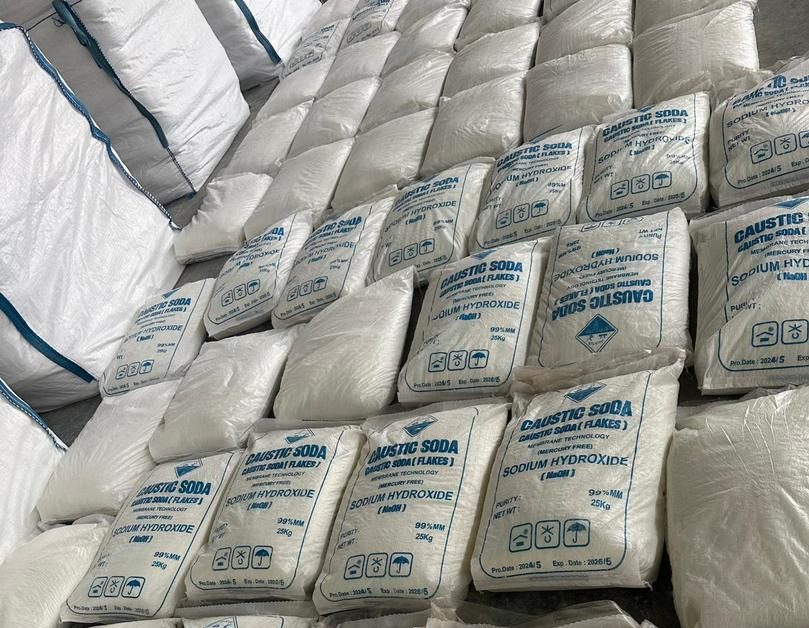
Sodium Hydroxide (NaOH): Properties, Applications, and Safety
What is Sodium Hydroxide?
Sodium hydroxide, commonly known as caustic soda or lye, is an inorganic compound with the chemical formula NaOH. It is a white crystalline solid that is highly caustic and can absorb moisture from the air. NaOH consists of sodium cations (Na⁺) and hydroxide anions (OH⁻), making it a strong base and alkali. It is widely used in many industrial processes and is known for its ability to decompose proteins at room temperature, making it a highly effective cleaning agent but also a potentially dangerous chemical.
Physical Properties of Sodium Hydroxide
- Appearance: White, odorless crystalline solid.
- Solubility: Highly soluble in water, where it liberates substantial heat upon dissolution.
- Corrosiveness:It is highly corrosive and can cause severe chemical burns when in contact with living tissues.
- Hydrates: It can form hydrates with water, such as sodium hydroxide monohydrate (NaOH.H₂O), which crystallizes from water solutions at temperatures between 12.3°C and 61.8°C. Commercial sodium hydroxide is often available as this monohydrate.
Applications of Sodium Hydroxide
Sodium hydroxide is used across multiple industries due to its strong alkalinity and effectiveness in breaking down organic materials. Some of its key uses include:
- Manufacturing of Pulp & Paper: It is essential in the process of breaking down wood to extract cellulose, which is used to make paper. It is also used in recycling processes to remove ink from paper.
- Textile Industry: It plays a key role in processing cotton, producing dyes, and laundering fabrics.
- Soap and Detergent Production: It is crucial in the production of soap and detergents, where it saponifies fats and oils to create soap.
- Water Treatment: Municipal water treatment facilities use sodium hydroxide to control the acidity of water and remove heavy metals.
- Food Processing: It is used to cure foods such as olives, create the signature crunch in pretzels, and remove skins from fruits and vegetables for canning.
- Energy Sector: It is used in the production of fuel cells, which generate electricity cleanly and efficiently. Additionally, it is a component in the manufacturing of epoxy resins used in wind turbines.
- Cleaning & Disinfectant Products: It is found in commercial products such as drain and oven cleaners, where it effectively dissolves grease, grime, and other organic materials.
Chemical Mechanism of Sodium Hydroxide
Sodium hydroxide’s extreme alkalinity makes it highly effective at breaking chemical bonds, particularly in proteins. This bond breakage leads to the decomposition of organic matter, which is why it is so effective in cleaning applications. However, prolonged contact with sodium hydroxide can lead to severe damage to living tissues, including necrosis and the breakdown of skin, hair, and nails. Its strong depilatory effects have been noted, particularly in industrial settings where accidental contact occurs.
Toxicity and Safety Information
Sodium hydroxide is highly toxic and corrosive. Exposure to it can cause severe health issues:
- Oral Ingestion: Consuming even a small amount (as little as 10 grams) can be fatal. Ingesting lye can cause severe tissue necrosis and stricture formation in the esophagus, potentially leading to death.
- Inhalation: Breathing in sodium hydroxide vapors can cause significant damage to the respiratory system, including irritation and, in severe cases, burns to the airways.
- Skin Contact: Direct contact with NaOH can result in chemical burns, necrosis, contact dermatitis, and hair loss. Long-term exposure has been linked to the development of tumors due to chronic irritation.
- Eye Exposure: It is extremely dangerous to the eyes, causing severe burns and possible blindness if not promptly treated.
Proper Packaging and Handling
Due to its corrosive nature, sodium hydroxide must be packaged and handled with extreme care.
- Solid Form (Flake): Typically packaged in 25 kg polypropylene (PP) bags, which can be consolidated into larger 1250 kg jumbo bags or secured on pallets with shrink wrap.
- Liquid Form: Transported in flexi tanks or steel drums to ensure safe handling and prevent leaks or spills.
Conclusion
Sodium hydroxide is a versatile and powerful chemical used in a wide range of industries, from paper production and food processing to energy and water treatment. However, its corrosive and toxic properties necessitate strict safety protocols when handling and using it. Understanding its chemical properties, applications, and potential dangers is critical for anyone working with sodium hydroxide.

